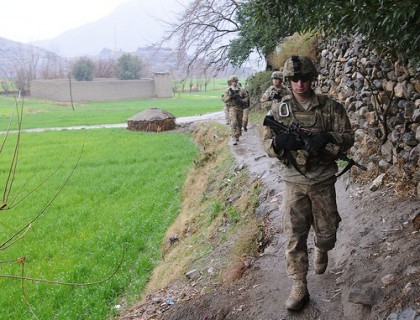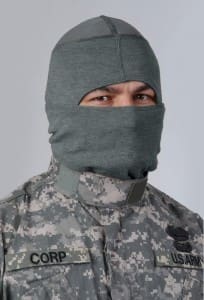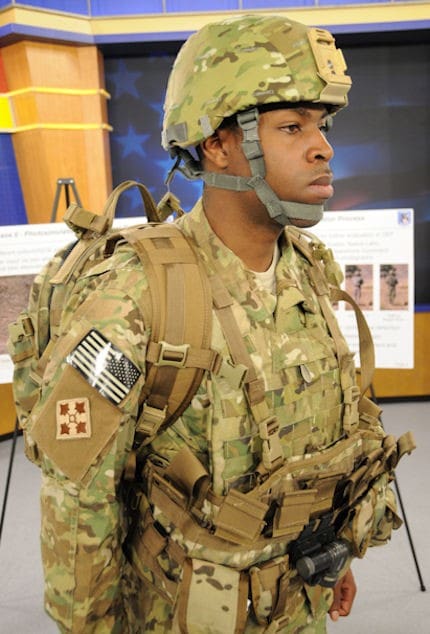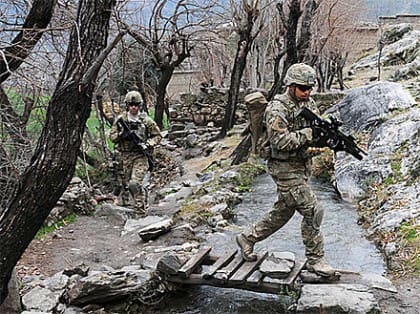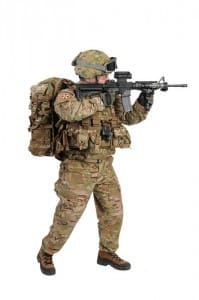 Back in December we broke the story that the Army’s PM Soldier Weapons was working with TACOM Rock Island to prepare a guide for painting weapons. COL Tamilio then brought it up at the PEO-Soldier Media Round Table at the Pentagon early last month and that’s when it hit the main stream media. When it hit the news stands it sounded like it was already authorized. I spoke with COL Tamilio about it and he said that they were, “still a few months out.” So I was pretty surprised when TACOM released a message on 1 April 2010 instructing Soldiers on how to paint their weapons. While the guide has been published, implementing instructions giving the go ahead have not yet been released. Who knows, maybe the Secretary of the Army will have to sign off on this one too. At least wait for unit leaders to get their heads wrapped around this like it says in the message. Guys in the Army are used to hurry up and wait but this accompanying photo from PEO-Soldier gives you a good idea of why this is so worthy of swift action. The Army seems to have gotten the pattern right, let’s see them camouflage the entire Soldier. Unfortunately, the message only covers individual rifles and carbines and does not address pistols or crew served weapons. Alas, Grenadiers will also look like the proverbial “football bat”.
Back in December we broke the story that the Army’s PM Soldier Weapons was working with TACOM Rock Island to prepare a guide for painting weapons. COL Tamilio then brought it up at the PEO-Soldier Media Round Table at the Pentagon early last month and that’s when it hit the main stream media. When it hit the news stands it sounded like it was already authorized. I spoke with COL Tamilio about it and he said that they were, “still a few months out.” So I was pretty surprised when TACOM released a message on 1 April 2010 instructing Soldiers on how to paint their weapons. While the guide has been published, implementing instructions giving the go ahead have not yet been released. Who knows, maybe the Secretary of the Army will have to sign off on this one too. At least wait for unit leaders to get their heads wrapped around this like it says in the message. Guys in the Army are used to hurry up and wait but this accompanying photo from PEO-Soldier gives you a good idea of why this is so worthy of swift action. The Army seems to have gotten the pattern right, let’s see them camouflage the entire Soldier. Unfortunately, the message only covers individual rifles and carbines and does not address pistols or crew served weapons. Alas, Grenadiers will also look like the proverbial “football bat”.
The Maintenance Information Message was released on 1 April 2010, and is eight pages in length when printed out. It goes into great technical detail on how to prep the weapon and paint it. Here are a few extracts.
Subject: Maintenance Information (MI) Message, TACOM Life Cycle Management Command, (TACOM LCMC) Control No. MI 10-040, Camouflaging Specific Small Arms, Items Affected: M16A2 Rifle, NSN 1005-01-128-9936, LIN R95035; M16A4 Rifle, NSN 1005-01-383-2872, LIN R97175; M4 Carbine, NSN 1005-01-231-0973, LIN R97234; M4A1 Carbine, NSN 1005-01-382-0953, LIN C06935.
Issue: This MIM supersedes the information as stated in 2.d.(5) of GPA (Ground Precautionary Action (GPA) Message which put the kybosh on commercial parts and accessories) 09-010 and 2.b.(4) of GPM 07-016 for the specific weapons listed in the subject of this message. The purpose of this message is to authorize at commander’s discretion the application of specific spray paint to be applied to specific small arms to aid in the camouflaging of our warfighters. The only small arms authorized to be camouflaged in accordance with this message are listed in the subject of the message. Additional weapons may be authorized in subsequent messages. Painting of weapons WILL NOT be conducted without the consent of the unit commander. Weapons MUST be stripped of paint prior to turn-in. Only two complete coatings of paint are authorized before weapon needs to be completely stripped.
3. Rationale: Warfighters must be able to conduct tactical operations while reducing/limiting detection by the threat. Camouflage paints provide for reduced visual detection and enhanced Warfighter survivability via neutral, non-reflective, and predominantly non-black colors. Weapon signature reduction (i.e., outline, and contrast with background, texture and color) aids in limiting Warfighters’ battlefield visual signature and makes it more difficult for the enemy to detect the Warfighter’s position. The color, black, is highly infra red reflective and black-colored weapons provide a high degree of visual contrast when carried by camouflaged uniformed Warfighters. Not only is the weapon itself more visible, but the type of weapon and type of accessories are more easily identified providing indicators to the Warfighter’s capabilities and position. Additionally, black color is more conducive to solar-loading (heat retention) than earth-tone colors. Some limited black color in irregular black shapes/patterns does provide for weapon outline breakup.”
Envision a plan: If you have not chosen how you are going to camouflage your weapon, decide at this time. Always start with a plan. Remember, most great camouflage is not pretty. The goal is to blend your weapon in with the environment in which you are operating. If you are operating in an environment that just has light tan sand, then just paint your weapon tan with limited black breakup. If you are operating in a jungle environment using brown and olive drab with limited black breakup may be appropriate for that environment. This procedure’s purpose is not to impress. Its purpose is to provide safety and another tool in defeating the enemy.
NOTE: Allow paint to dry before applying another color. DO NOT spray the paint on heavy. Test the paint on cardboard or a paper towel before painting the weapon so you know how much pressure you need to apply to get a thin coat.
TIPS: Good camouflage can be achieved many ways. Some may want to place netting or foliage such as grass or leaves on the weapon and paint around it to better blend into the environment.
Others may just want to use a blending technique. When using the blending technique coat the weapon with the lightest color you will be using. Next take a darker shade that blends with your environment and paint stripes about 4 inches apart at a 45 degree angle. You can do this with 1 to 2 colors. Next you need to blend it in. Take a dark color like green or brown and from about 6 to 8 inches away from the weapon lightly dust the gun. After that take a lighter color (khaki, or tan) and lightly dust the gun from 6 to 8 inches away. This will blend everything together and dull the finish. Colors will depend on operational environment.
Spray Paint – order spray paint through GSA using the below part numbers:
Part Number
1916830 Black
1917830 Khaki
1918830 Earth Brown
1919830 Deep Forest Green
1920830 Army Green


